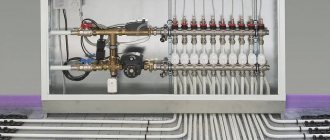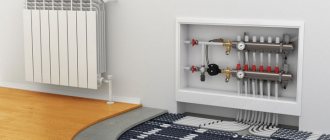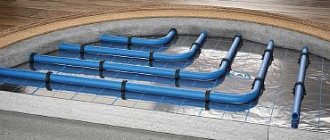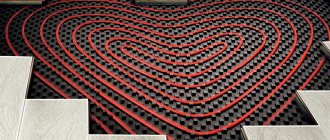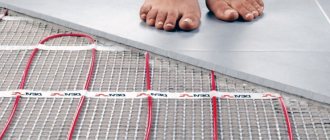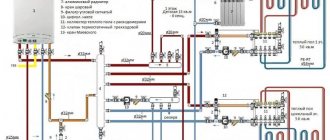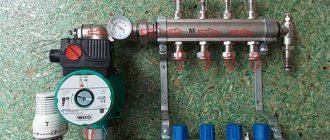Organizing water underfloor heating is not a cheap undertaking. To realize all the benefits of surface heating, the homeowner has to bear the cost of purchasing large quantities of pipes, installing them and installing a cement screed. You won’t be able to save money on this, but it is quite possible to assemble the most expensive component of the system with your own hands - a manifold for a heated floor. Let's look at the options for homemade distribution combs and figure out how you can make them yourself.
Purpose of the collector
In the design of a water heated floor, the collector acts as a device that facilitates the uniform flow of already heated liquid to all areas of the floor heating system.
The distributor is installed together with the control valves and the pump. Sometimes a bypass is also required in the kit of such a mixing unit. Thanks to the manifold, a continuous working process of all branches of the heated floor is ensured.
The design of the switchgear includes heat monitoring devices, air filters, shut-off and temperature control sensors and thermometers. Using this equipment, the temperature regime is adjusted:
- hot water enters the collector;
- The device facilitates mixing of the heated coolant with the already cooled return flow.
This process allows water to enter the underfloor heating system at a temperature not exceeding the required values.
Electromagnetic flow meters
Connecting a heated floor to a thermostat
Their operating principle is based on the law of electromagnetic induction, according to which an emf is induced in an electrically conductive liquid passing through an electromagnetic field, proportional to the speed of the flow (conductor).
Such flow meters have found application in volumetric metering systems for coolant and water at industrial and energy enterprises. Disadvantage: high cost and weight for diameters greater than 300-400 mm, difficulty in removing for verification.
Rod electromagnetic water meters operate on the principle of immersing a sensor in a liquid, where the flow rate is measured. Such meters determine the flow of cold water in completely filled pipelines.
Collector types
Devices for distributing coolant in a heated floor system are produced in various types. Collectors differ in the method of adjustment, material of manufacture and technical parameters. According to these indicators, there are several main types of distributors.
With manual adjustment
Such a device has a low cost, so it is installed mainly by those who want to save on equipment. With the help of such a manifold, the temperature of the liquid in the floor heating system is adjusted in the mixing unit. In this case, for each individual branch, the coolant is supplied once by manual adjustment. After setting the parameters, the system carries out the further work process independently.
Warm floor collector diagram
Manually controlled collectors are mainly used for underfloor heating, which is an additional equipment to the main heating system. Such distributors made of brass have good characteristics.
No adjustment
A device of this type is considered the most budget option. The device does not have any adjustment devices. The distribution of coolant in a collector of this type is carried out by the system in hydraulic mode.
This device is completely unsuitable for efficient operation of a heated floor. Installing the manifold without adjustment can cause the entire system to fail.
With automatic type adjustment
This type of distributor is widely used for many underfloor heating systems. The coolant is controlled using built-in automatic and control elements, as well as various sensors.
When installing such a device, high-quality configuration is required. The cost of a manifold with automatic control is significantly higher than that of a simple type of distributor. But such costs are justified because with the help of such a device you can constantly maintain a comfortable temperature in the room without any problems.
Distributor with flow meters
The design of the collector includes flow indicators that allow you to control the volume of coolant used to maintain the set temperature regime. In this case, the distributor also performs its main functions.
Due to additionally installed shut-off valves, liquid flow control can be carried out for each individual branch. Despite the high technical characteristics of distributors of this type, their cost is relatively low.
Cross-correlation ultrasonic counters
Such flow meters operate using the ultrasonic signal cross-correlation method. This technique is based on the principle of constructing velocities at different flow levels; the meter makes it possible to construct a real diagram of the distribution of velocities in the flow. The flow level is also measured.
Ultrasonic pipe and wedge-shaped speed sensors installed in the flow are used with water meters; the liquid level is determined using surface and underwater sensors. It is possible to design combined speed and level sensors.
Meters are used in pressure and gravity, open and closed systems. This is an accurate measurement method that gives reliable results for flows of varying degrees of contamination, including it is effective in heterogeneous media. Flow meters are used in process pipelines, wastewater treatment plants, rivers and reservoirs, etc. In large channels, several sensors can be installed across the entire width to obtain more accurate results.
Criterias of choice
When purchasing manifolds for heated floors, it is recommended to take into account three main factors influencing the choice of product:
- Material of manufacture. Steel collectors are considered the most reliable. They are strong and durable. Brass and bronze distributors also have good reviews. Devices made of polypropylene have the lowest cost, but their installation is permissible at low heating temperatures.
- Number of circuits. This parameter must be taken into account when connecting a floor heating system. It is best to buy a manifold with an emergency outlet. This will allow you to connect additional equipment without any problems in the future or organize separation of branches if necessary.
- Adjustment method. The best option is a collector with automatic control. A device with manual adjustment can normally service the system, but such a device is not suitable for main heating systems.
Before purchasing a distributor, you must carefully study the package contents of the device and visually inspect the product to exclude the presence of cracks in its design.
Device and connection diagrams of the collector
The manifold assembly in the floor heating system ensures efficient and uninterrupted operation of all underfloor heating lines. It includes the following devices:
- pump;
- balancing valves;
- collector group;
- thermostat with sensor;
- mixing valve;
- devices that remove air bubbles in the system;
- pressure gauges.
Connection diagram for the HKV collector 4 outputs 3/4 Watts
The collector unit also includes connecting devices for pipes of various diameters.
Purpose and types of valves
The manifold system necessarily includes mixing valves, which allow control of the coolant in the heated floor circuits.
Their job is to combine too hot water from the boiler with the cooled coolant in the system. Such mixing is necessary to obtain the desired temperature for heating the heated floor.
There are two types of mixing valves:
- Two-way. Such a valve is able to regulate the temperature and independently add the required amount of hot or cold coolant. When installing two-way mixing devices, there is no overheating of the heated floor. The use of such valves is allowed in rooms with a maximum area of 200 square meters.
- Three-way. The installation scheme of such a valve includes those programmed to change the temperature regime depending on weather changes. Three-way thermal devices are used in underfloor heating systems for large rooms whose size exceeds 200 square meters.
Doppler method
Counters operating using this method measure the difference in wavelength reflected from a moving stream relative to the wavelength of the emitted signal. Measuring the received and transmitted signals to determine the difference between them is done using wedge-shaped or pipe speed sensors installed at the bottom of the channel or pipe.
Water meters operating on the Doppler effect are used in pressure and gravity systems, fully and partially filled pipes, and open channels. They work in streams of varying degrees of pollution (except clean water). Doppler flow meters are used for commercial metering in pipelines and gravity canals, for measuring flows in rivers and canals of irrigation systems, in storm sewers, at pumping stations, water intake pipelines and discharge of wastewater into reservoirs.
Homemade collector
To make a manifold for a heated floor with your own hands, you must correctly carry out all the calculations and select the component elements. The quality of the underfloor heating system will depend on the accuracy of the device’s manufacturing. Therefore, it is recommended to begin assembling the device only if you understand the operating principle of heating equipment.
Material selection
To assemble the collector, the following devices are required:
- A piece of pipe for the manifold body. Bends are cut into it, with the help of which the connection to the heated floor is made. The pipes can be purchased at the store or made independently by welding. If the distributor is supposed to be made of polypropylene, then the product is soldered with a special soldering iron.
- A manifold installed on the coolant supply requires a valve. Such a shut-off control device is installed on each circuit.
- An air vent valve is connected to the top of the structure, which helps bleed air from the system.
- The switchgear is mounted on brackets. You can make such fasteners yourself or pick them up at a hardware store.
- Coolant drain tap.
- Connecting parts, tees.
Metal-plastic pipelines are installed using special fasteners.
Calculations
For proper installation of the collector, it is necessary to calculate the main parameters of the system. All calculations are carried out according to the selected system installation diagram.
Before assembling and installing the floor heating distributor, it is necessary to determine:
- the number of heating equipment in the work process in which the collector will participate;
- the number of branches included in the floor heating system and their characteristics;
- underfloor heating parameters – maximum temperature regime of the coolant, the amount of liquid required to fill the branches;
- location of the distribution node.
When manufacturing a collector, it is necessary to take into account its diameter. The cross-sectional area of the pipe from which the distributor is made must match or be slightly larger than the cross-sectional area of the pipelines connected to the device.
Assembly
If the collector is made of a metal pipe, a welding machine is required. The required size of the workpiece is hermetically welded at both ends. Steel bends are welded to the prepared pipe sections to connect pipelines. It is recommended to position them so that it is convenient to connect the device.
The connection areas for other components, including the air vent valve and taps, are also determined. The main point of assembling the collector is the tightness of all connections.
A homemade metal manifold requires a protective coating against corrosion. Therefore, it is better to open it with a special primer and paint it.
Stages of manufacturing a distribution comb
Drawing up a heating project
When drawing up a diagram of the passage of branches and connections to the collector, many issues should be taken into account.
- How many heating branches will be suitable for the heating boiler?
- What type of heating boiler and its operating characteristics. Sometimes there are two or more heating devices.
- The number and description of the characteristics of heating devices that will be connected to the system in subsequent years (solar panels or fuel pumps, etc.).
- Description of the operation of all additional equipment, storage water tanks, feed valves, pressure gauges and thermometers, sensors and safety groups for them.
- It is necessary to determine the parameters for connecting each of the devices to the system, direct and reverse supply of warm water.
- A diagram of the entry of the pipe of each circuit into the collector is drawn up. Pipes of solid fuel boilers and additional heating boilers are usually located on the sides of the collector. If a gas or electric boiler is connected without using a hydraulic arrow, then it is also cut in from the side. If not, then it is more convenient to enter from above.
- The inlet of the heating circuit pipes is located at the top and bottom of the comb. The distance between the entrances can be made in arbitrary sizes, but it is recommended to make them 10–20 cm. To visually highlight each circuit, it is recommended to keep the gap between the direct and return entrances and keep the heating boiler the same.
- For all devices included in the system, such as pumps, modules, etc., the distance between the return flow and the outlet is indicated in the technical parameters and must be strictly maintained.
Manufacturing process
It is most convenient to make a distribution manifold from a square pipe .
First, we prepare two sections of pipe according to the given dimensions, cut the sections to create outlet pipes from molded products of round cross-section. Be sure to clean all parts from rust; it is advisable to treat them with an anti-corrosion compound.
On the body of the pipe, mark the holes for future entrances and exits, checking the diagram drawn up earlier. After checking the data, drill all holes. Next, you need to start assembling the manifold, secure all the connections between the pipes and the manifold by welding, carefully scalding all threads and pipes. After welding the selected type of fastener, knock off the scale and clean the welding areas. All that remains is to paint the collector with oil compounds to protect it from corrosion and give it a finished look.
Features of operation
A correctly made and connected collector is quite easy to operate. Temperature adjustment, supply and distribution of coolant into the system are carried out automatically. But for preventive purposes, periodic testing of the system is required. This procedure consists of the following steps:
- checking the functionality of all elements of the switchgear;
- monitoring the tightness of connections to avoid leaks during system operation;
- clarification of the characteristics of the coolant in each individual branch - maximum heating temperature, time spent on heating, speed.
It is also necessary to check the compliance of the temperature regime in the system with the specified parameters. To do this, you need to set a certain temperature and take readings from thermometers installed in the collector assembly.
A do-it-yourself collector will help you avoid high costs for the heating system. Its assembly must be carried out strictly according to the diagram. If you do not have any experience in installing heating devices, then it is better to entrust the connection to professionals. High-quality and continuous monitoring of a heated floor can only be carried out with proper connection of the switchgear and the correct selection of all components of the manifold assembly.
Video VALTEC manifold block
Secrets of treating joint pain from our regular reader.
My name is Genady Alekseevich. I am a stove maker with over 20 years of experience. I am engaged in both repair and construction of Russian stoves and fireplaces. I always perform the work very efficiently and carefully, which negatively affects the condition of the joints. As I grew older, the pain began to get worse, to the point where I could no longer work. Having tried many medicinal and traditional methods of treatment, I realized how serious my disease was, since there was no positive effect. Until I came across one remedy that I want to tell you about.
This is a unique mixture of the rarest and most powerful natural healing substances. This remedy has proven its effectiveness not only for patients, but also for science, which has recognized it as an effective drug. Pain in the joints and back goes away in 10-15 days, as studies have shown. The main thing is to strictly follow the instructions in the method. Order the product in its original packaging. with quality assurance available on the official website.
Dubinsky: “It is necessary to treat joint pain first of all by eliminating it.
How many times to repeat: pigment spots instantly disappear from the usual ones.
Do you want to bring your girlfriend to ecstasy. Use the trouble-free new product.
Arthritis is a direct path to disability! How to save yourself.
